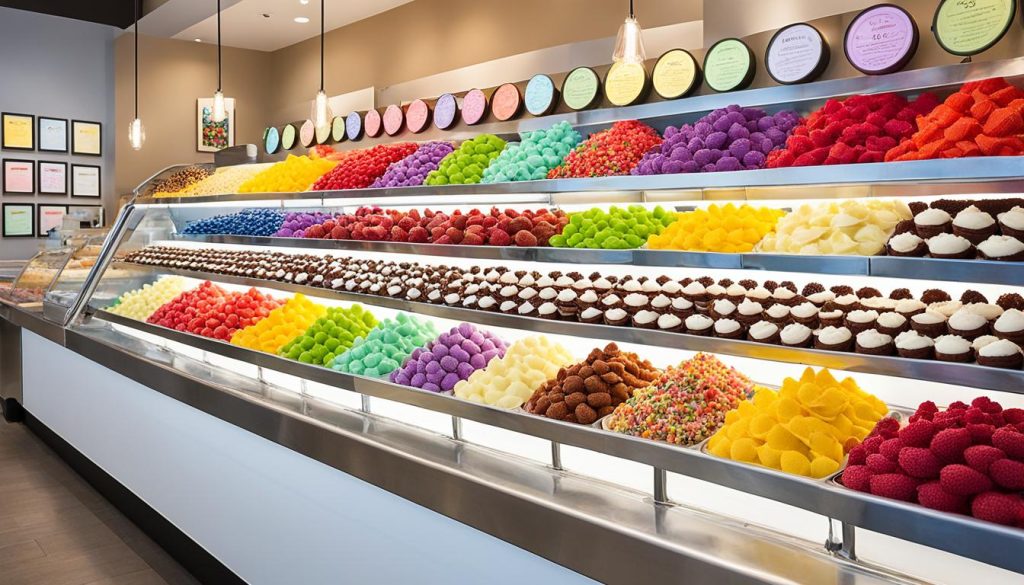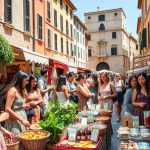Italy is famous for its rich culture and beautiful landscapes. It’s also known for its amazing food scene. With a mix of tradition and innovation, Italy offers a unique food experience. From local treats to famous dishes, it delights food lovers worldwide.
Starting a food journey in Italy reveals a world of flavors. Each region has its own special foods, creating a rich mix of tastes and textures. You can enjoy handmade pasta, try the famous pizza, or explore Italian cheeses and cured meats. Every bite takes you to the heart of Italian food.
Italian food is loved all over the world. Things like gelato, seafood, truffles, coffee, and wine have become famous globally. These foods show Italy’s commitment to quality and skill, making meals special.
In Italy, you can find food for any taste. Whether you want a quick snack or a fancy meal, there’s something for everyone. From street food to top-rated restaurants, the choices are endless.
For those wanting to learn about Italian cooking, there are classes to take. Visiting food festivals and markets is also a great way to dive into the local food scene. These places are full of fresh produce and local treats.
Key Takeaways:
- Italy is renowned for its famous food scene, attracting culinary enthusiasts from around the world.
- Italian cuisine combines tradition and innovation, creating a delightful blend of flavors.
- Each region in Italy has its own unique culinary specialties, adding diversity to the food scene.
- Pasta, pizza, cheeses, cured meats, gelato, seafood, truffles, coffee, and wine are iconic elements of Italian gastronomy.
- Italy offers a range of dining experiences, from street food to Michelin-starred restaurants, catering to all tastes and preferences.
Italian Cuisine: A Blend of Tradition and Innovation
Italian cuisine is famous for its rich tastes and aromatic ingredients. It shows off Italy’s cultural heritage and regional traditions. But it’s not just about old recipes; it’s also about new ideas. This mix of old and new makes Italian food special, exciting food lovers worldwide.
Italian cooking values fresh, quality ingredients. Things like juicy tomatoes, sweet basil, and salty Parmigiano-Reggiano are key. These ingredients have been passed down for generations, forming the base of Italian cooking. This foundation lets chefs add new twists to classic dishes.
Pasta is a great example of this mix of old and new. For centuries, Italians have loved pasta. Now, chefs are adding new flavors and styles, making pasta exciting again. From black spaghetti to truffle ravioli, these dishes are both new and true to Italian roots.
Italian Cuisine: A Journey of Senses
Italian food is more than just tasty; it’s a feast for the senses. The bright colors of a Caprese salad, the smell of garlic sauce, and the feel of al dente pasta make it special.
Italian chefs add passion and art to the food, making it a treat for the eyes. Dishes look like art, with their colors and garnishes. Italy’s food scene ranges from fancy restaurants to cozy trattorias.
The Impact of Innovation
Innovation in Italian food goes beyond cooking and presentation. It includes sustainable farming, new technology, and changing how we eat. Chefs and restaurants are using organic farming and reducing waste, caring for the planet and supporting local farmers.
Technology has changed how we enjoy Italian food too. Apps give us recipes, food delivery brings meals to our doors, and online classes teach us to cook. These changes make Italian food available to everyone, linking tradition with today’s world.
Italian cuisine’s mix of tradition and innovation makes it a favorite around the globe. It delights with its flavors, classic recipes, and new ideas. Whether it’s a traditional carbonara or a modern dish, Italian food celebrates the joy of good food.
Regional Delicacies: Diverse Flavors Across Italy
Italy’s culinary traditions are rich and varied, thanks to its regional delicacies. Each region has its own special dishes and ingredients. These are shaped by local culture, geography, and history.
In the south, Sicilian cuisine is full of life and passion. You’ll find seafood, citrus fruits, and exotic spices. Try arancini, fried rice balls, or cannoli, sweet pastries filled with ricotta.
Heading north, Tuscany offers simple yet delightful food. It’s all about local ingredients like Florentine steak and ribollita, a vegetable and bread soup. Don’t miss the rich flavors of pecorino cheese and olive oils.
Traditional Dishes from Lombardy
Lombardy in the north has its own unique tastes. Enjoy creamy risottos and hearty stews. Try risotto alla Milanese or ossobuco, a tender veal shank dish.
Italy’s regions offer a wide range of specialities. From the earthy porcini mushrooms in the northeast to fresh seafood on the Mediterranean coast, the flavors are diverse.
Discovering Local Produce
Visiting local markets in Italy is a must. They’re full of vibrant colors and enticing smells. Each season brings new fruits, vegetables, cheeses, and meats, showing off Italy’s culinary heritage.
Whether you’re in the south with its rich flavors or the north with its simple tastes, Italy’s regional delicacies will take you on a delicious journey. Each bite celebrates the country’s diverse flavors.
Pasta: The Heart of Italian Cuisine
Pasta is a key ingredient in Italian cuisine, loved by food lovers worldwide. It’s a staple that shows Italy’s rich food culture and passion. This versatile dish is a symbol of Italian cooking.
Pasta has a long history, with Marco Polo possibly bringing it back from China. Its true origins are still a topic of debate. But its impact on Italian culture and food is clear.
What makes pasta special? It’s the skill in making it, the quality of ingredients, and the variety of shapes. These shapes work well with different sauces and dishes. From spaghetti to rigatoni, pasta offers endless creativity in the kitchen.
Italian cooking is all about simple yet perfect flavour combinations. Pasta dishes show this well, with each region having its own recipes and sauces. For example, Bolognese from Emilia-Romagna and Carbonara from Rome are famous. Each sauce and pasta shape together create a perfect taste experience.
Pasta isn’t just a main course; it can be a starter or a side dish. In Italy, starting a meal with a small pasta dish, or “primi piatti,” is common. This shows how important pasta is in Italian meals and the flavour it adds.
To learn about pasta, explore its varieties, shapes, and cooking methods. You can do this by taking cooking classes or visiting pasta factories in Italy. This way, you’ll see the effort and skill that go into making pasta.
Types of Pasta Shapes
There are many pasta shapes to discover. Here are some well-known ones:
- Spaghetti
- Penne
- Rigatoni
- Fettuccine
- Tortellini
- Ravioli
Each pasta shape is unique, making it perfect for certain sauces. For instance, rigatoni’s ridges are great for meat sauces. Tortellini’s hollow centre is ideal for filling with cheese or meat.
The Perfect Pairings
There are countless pasta sauces to try. Here are some classic ones:
| Pasta Shape | Sauce |
|---|---|
| Spaghetti | Bolognese |
| Penne | Arrabbiata |
| Fettuccine | Alfredo |
| Tortellini | Pesto |
These are just a few examples of pasta and sauce pairings. The best way to find your favourites is to keep trying new combinations.
Pasta is the heart of Italian cuisine. It’s versatile, has a rich history, and brings people together. So, enjoy a plate of pasta and taste the passion and love in every bite.
Pizza: Italy’s Most Beloved Dish
Pizza is a top choice in Italian cuisine. It has won the hearts of people worldwide. Originally, it was a street food in Naples, Italy.
It started in the 18th century with a simple recipe. The dish was flatbread with tomatoes, cheese, and herbs. Soon, pizzerias sprouted in Naples. Then, it spread to the US and other places.
Now, there are many pizza types, each with its own twist. You can try the Neapolitan Margherita or Roman-style pizza. Each offers unique flavors and textures.
The Irresistible Charm of Neapolitan Pizza
Neapolitan pizza is the original and most traditional type. It has a soft crust and few toppings. This lets the ingredients shine.
The dough is made with flour, water, yeast, and salt. It rises for hours to get its special taste and texture. Baked in a wood oven, it becomes light yet full of flavor.
Choosing the best ingredients is key. San Marzano tomatoes and buffalo mozzarella are essential. Fresh basil and extra virgin olive oil complete the classic taste.
Regional Variations: Beyond Margherita
While Naples loves the Margherita, other regions have their own pizza styles. Rome’s pizzas are thin and crunchy, topped with prosciutto and arugula. Florence’s pizza is thick and fluffy, seasoned with olive oil and salt.
Sicily offers a thicker crust pizza with tomatoes, anchovies, and olives. No matter where you go, you’ll find a pizza that you’ll love.
| Italian Pizza Varieties | Description |
|---|---|
| Neapolitan Pizza | Traditional, soft and chewy crust with minimal toppings. |
| Roman Pizza | Thin and crispy crust, with a wide variety of toppings. |
| Florentine Pizza | Thick and fluffy crust, typically seasoned with olive oil and salt. |
| Sicilian Pizza | Thick crust, topped with tomatoes, anchovies, olives, and capers. |
Cheeses and Cured Meats: A Gastronomic Symphony
Italian cuisine is all about the perfect mix of cheeses and cured meats. These two foods are key to Italy’s rich food culture. They offer a unique taste experience for those who love food.
Italian cheeses are famous for their quality and variety. They range from the bold Parmigiano Reggiano to the creamy Mozzarella di Bufala. Each cheese has a story of tradition and skill behind it.
The cured meats of Italy are just as special. Prosciutto is a top example, known for its curing skills. It’s made from the best pork, salted and dried in the air. Other great meats include salami, pancetta, and bresaola, all showing off Italian charcuterie skills.
Enjoying Italian cheeses and cured meats together is a must. Their mix of flavors, textures, and smells is amazing. They’re perfect for snacks, pasta dishes, or with wine on a cheese board.
The Perfect Pairings
Pairing cheeses and cured meats lets food lovers enjoy a wide range of tastes and textures. Here are some classic pairings that always impress:
| Cheese | Cured Meat |
|---|---|
| Gorgonzola | Mortadella |
| Pecorino | Speck |
| Fontina | Prosciutto di Parma |
These pairings bring together the salty and rich flavors of the meats with the creamy cheeses. Trying different combinations is a great way to discover new tastes and find what you like best.
Italian cheeses and cured meats are not just tasty. They’re also a celebration of Italy’s food heritage. They show the hard work and love of artisans keeping old traditions alive.
Gelato: Italy’s Cool Creamy Creation

Enjoy the heavenly delight of Italian gelato, a frozen treat loved worldwide. Gelato means “frozen” in Italian. It’s a dessert that shows off Italian artistry and passion.
Gelato is different from ice cream because it’s smooth and creamy. This is thanks to more milk and less cream. It tastes more intense and is lighter.
Italian gelato has many flavors, from vanilla and chocolate to pistachio and salted caramel. Each flavor uses fresh ingredients like real fruits and nuts.
Gelato’s bright colors show its quality and freshness. You’ll see everything from lemon yellow to cherry red. Each flavor is a treat for your eyes and taste buds.
The Gelato Experience: Beyond Flavors
Gelato is more than just flavors. It’s a journey for your senses. Walking through Italy, you’ll see gelato shops with amazing colors and flavors.
The smell of waffle cones and fresh gelato is hard to resist. Inside, friendly artisans make beautiful gelato. They scoop it into shapes that look almost too good to eat.
Gelato Parlors: An Italian Tradition
Gelato parlors, or “gelaterie,” are a big part of Italian life. People go there for a scoop or two of their favorite flavors. You’ll find them in Rome and Tuscany, where they bring people together.
Many gelato artisans spend their lives perfecting their craft. They try new flavors and techniques to innovate gelato. This keeps gelato exciting and new.
Gelato is enjoyed in many ways, like in a cup or a cone. It’s a mix of tradition and innovation, with quality ingredients and craftsmanship.
Popular Gelato Flavors
| Classic Flavors | Fruit Flavors | Decadent Flavors |
|---|---|---|
| Vanilla | Lemon | Stracciatella |
| Chocolate | Strawberry | Tiramisu |
| Pistachio | Mango | Cookies and Cream |
Gelato has something for everyone, from classics to fruit flavors to decadent treats. It’s a taste sensation that takes you straight to Italy.
Seafood: Fresh Catches from the Mediterranean
Italy’s coasts are rich in fresh seafood, thanks to the Mediterranean Sea. This sea is key to Italian food, offering a wide variety of fish and shellfish. These are used in traditional dishes.
Spaghetti alle vongole is a classic dish from southern Italy. It’s made with clams, garlic, white wine, and olive oil. This dish shows the simple yet elegant side of Italian cooking. The clams and pasta together create a mix of flavors loved worldwide.
Grilled branzino is another Mediterranean treat in Italy. It’s a type of European sea bass, grilled with olive oil and sea salt. This dish captures the essence of Italian coastal food. The fish is tender and goes well with herbs like rosemary and thyme, making it a delightful meal.
Visiting the coastal towns and their markets is the best way to enjoy Italian seafood. These markets show off the day’s catch, offering a wide range of seafood. You can find everything from prawns to calamari, giving seafood lovers a treat for the senses.
Celebrated Italian Seafood Dishes:
- Fritto misto di mare: A delightful assortment of fried seafood including calamari, shrimp, and small fish.
- Cacciucco: A hearty fish stew originating from the coastal regions of Tuscany, featuring a mix of various fish and shellfish.
- Baccalà mantecato: Creamy whipped codfish that is a popular appetizer or spread in Venetian cuisine.
- Scampi alla busara: Whole langoustines cooked in a flavorful tomato-based sauce, a specialty of the Adriatic coast.
Italian Seafood: Nutritional Value and Health Benefits
Seafood is not just delicious; it’s also good for you. It’s full of omega-3 fatty acids, vitamins, and minerals. These nutrients help keep your heart healthy, support brain function, and boost overall well-being. The Mediterranean diet, which focuses on seafood and fresh ingredients, is seen as one of the healthiest diets.
| Seafood Variety | Nutritional Highlights |
|---|---|
| Salmon | High in omega-3 fatty acids, vitamin D, and protein. |
| Sardines | Excellent source of calcium, vitamin D, and omega-3 fatty acids. |
| Mussels | Rich in iron, vitamin B12, and selenium. |
| Octopus | Low in fat, high in protein, and a good source of iron and vitamin B12. |
Enjoying Italian seafood is good for both your taste buds and your health. Italy’s seafood heritage is rich and varied, offering a wide range of delicious options.
Truffles: The Black Diamond of Italian Cuisine
We’re diving into the world of Italian truffles. We’ll talk about the different types, how they’re grown, and their role in making dishes special. They’re truly a luxury ingredient.
Truffles are a top ingredient in Italian cooking. They’re called the “black diamond” because they’re rare and very valuable. These special fungi live underground, near certain trees, and are loved for their unique taste and smell.
The Different Varieties of Truffles
Italy is home to many truffle types, each with its own taste and smell. Here are some popular ones:
- Black Truffles (Tuber melanosporum): These have a strong smell and earthy taste. They’re harvested from late autumn to early spring.
- White Truffles (Tuber magnatum): These are the most expensive and have a strong smell and a light, garlicky taste. They’re found in some parts of Italy and are picked from September to December.
- Summer Truffles (Tuber aestivum): Harvested in summer, these have a milder taste. They’re great for adding flavor to dishes without taking over.
Cultivation of Truffles
Truffle farming is all about creating the perfect conditions for them to grow. It takes careful tree selection, the right soil, and specific environmental factors.
Truffles work closely with certain tree roots. This relationship helps the truffles get nutrients from the tree and the tree gets better access to water and nutrients from the soil.
Enhancing Italian Dishes with Truffles
Truffles add a unique flavor and aroma to Italian dishes. They’re often shaved or grated over pasta, risotto, and eggs. They can also be mixed into sauces, oils, and spreads to add depth to many recipes.
In fancy restaurants, chefs love to use truffles in creative dishes. From truffle pasta to truffle desserts, the options are endless.
| Variety | Flavor | Harvest Season |
|---|---|---|
| Black Truffles (Tuber melanosporum) | Earthy | Late autumn to early spring |
| White Truffles (Tuber magnatum) | Garlicky | September to December |
| Summer Truffles (Tuber aestivum) | Subtle | Summer |
Coffee: The Art of the Italian Espresso

Italy is famous for its coffee culture. No visit to Italy is complete without exploring the art of the Italian espresso. Espresso is a key part of daily life and social events in Italy.
The history of coffee in Italy goes back centuries. The first coffeehouses opened in the 17th century. Since then, coffee has become a big part of Italian life. It stands for relaxation, chatting, and enjoying life.
The Italian espresso is a masterpiece of coffee. It’s made with finely ground beans and hot water pressed through a compact puck. This creates a small, strong shot full of flavor. The taste, smell, and crema of Italian espresso are unique, making it a key part of Italian food.
To enjoy Italian espresso, you need to know the rituals around it. Italians drink their espresso quickly, often at a café. It’s a moment to chat with friends, enjoy some banter, or just relax.
The Role of Coffee in Italian Cuisine
Coffee is a big part of Italian food. It goes well with many traditional dishes. Whether it’s an espresso after a meal or a coffee dessert, coffee is always there.
Italian coffee culture has also led to famous drinks like cappuccino and macchiato. These drinks show how versatile coffee can be, adding luxury to everyday life.
The Coffee Regions of Italy
Italy’s coffee-growing areas are as varied as its cuisine. The south offers bold flavors, while the north has milder tastes. Each region has its own unique coffee style.
Here’s a look at Italy’s main coffee regions:
| Region | Flavor Profile |
|---|---|
| Naples | Bold, intense, dark chocolate notes |
| Sicily | Rich, full-bodied, with hints of bitterness |
| Rome | Smooth, medium-bodied, balanced |
| Turin | Light, aromatic, with fruity undertones |
| Trieste | Complex, vibrant, with floral and nutty nuances |
Exploring Italy’s coffee regions is an adventure. It lets you taste the diverse flavors and traditions that make Italian coffee special.
Whether you’re enjoying a classic espresso, a frothy cappuccino, or a regional coffee, diving into the Italian espresso culture is key to experiencing Italy’s rich food scene.
Wine: A Taste of Italy’s Terroir
Italy’s food scene is famous for its wine culture. Italian wines are loved worldwide, matching the rich tastes of Italian food. From full-bodied reds to light whites, each wine tells a story of Italy’s varied regions and their unique terroir.
Italy has many wine regions, each with its own special taste. The climate, soil, and landscape shape the wine’s character. This leads to a wide range of grape types and winemaking styles, showing off Italy’s terroir.
The Variety of Italian Wine Regions
Italian wines are sorted into four types based on where they come from: DOCG, DOC, IGT, and VDT. These labels mean the wines meet strict quality standards and keep their regional identity.
Some top wine areas in Italy include:
- Piedmont: Known for its top wines like Barolo and Barbaresco, Piedmont’s vineyards are in the Langhe hills.
- Tuscany: Famous for its Sangiovese grape, Tuscany makes great wines like Chianti Classico and Brunello di Montalcino.
- Veneto: It’s home to Prosecco and elegant Amarone, making it a favorite among wine lovers.
- Sicily: The largest Mediterranean island, Sicily is known for its unique grape varieties and wines with a volcanic twist.
A Kaleidoscope of Grape Varieties
Italy’s wines come in a wide range of grape types, both local and from abroad. The country is proud of its native grapes, which add special flavors to the wine. Sangiovese, Nebbiolo, Barbera, and Montepulciano are some of these gems.
But Italy also welcomes international grapes like Chardonnay, Cabernet Sauvignon, and Merlot. This mix of old and new lets winemakers create exciting wines that win fans globally.
Exploring Italian Wine: A Journey of the Senses
Start a journey through Italy’s wine regions to find a world full of passion and unique tastes. Want to learn more about Italian wines? Try a wine tasting tour or visit famous wineries. There, experts will show you the beauty of each wine.
| Region | Grape Varieties | Notable Wines |
|---|---|---|
| Piedmont | Nebbiolo, Barbera, Dolcetto | Barolo, Barbaresco, Barbera d’Asti |
| Tuscany | Sangiovese, Cabernet Sauvignon, Merlot | Chianti Classico, Brunello di Montalcino, Super Tuscans |
| Veneto | Garganega, Corvina, Rondinella | Prosecco, Amarone della Valpolicella, Soave |
| Sicily | Nero d’Avola, Frappato, Catarratto | Etna Rosso, Marsala, Grillo |
Enjoy a glass of Italian wine and feel like you’re in the Italian countryside. Whether with pasta or on its own, Italian wine shows the country’s love for food and terroir.
Street Food: A Gastronomic Adventure on the Go
Discover the exciting world of Italian street food. From the famous arancini to the tasty focaccia, there’s a lot to explore. These snacks are easy to find in Italy’s cities and towns.
Arancini: Deep-Fried Delights
Arancini, or “little oranges,” are a hit in Italy. They’re rice balls filled with mozzarella, ragù, or spinach. Then, they’re coated in breadcrumbs and fried until golden.
This makes them a mix of creamy and crunchy that’s hard to beat.
Panzerotti: Savory Stuffed Pockets
From southern Italy, panzerotti are a tasty street food. They’re like mini calzones. These pockets are filled with mozzarella, tomatoes, and more.
They’re either fried or baked, making them a great snack for those on the move.
Focaccia: The Versatile Flatbread
Focaccia comes from Liguria and is loved by many. It’s a flatbread that can be simple or topped with various ingredients. Enjoy it plain or with toppings like tomatoes and olives.
It’s a perfect snack to taste the real Italian flavors.
Porchetta Sandwich: Succulent Roasted Pork
The porchetta sandwich is a treat for meat fans. It’s made with slow-roasted pork in a roll, drizzled with olive oil. The meat is tender, and the bread is crispy, making a great mix of flavors.
Zeppole: Sweet Fried Dough
Zeppole are a must-try street food in Italy. These fried dough balls are a favorite at festivals. They’re covered in powdered sugar and can be filled with custard or chocolate.
They’re a sweet treat that brings a taste of Italy to your mouth.
| Street Food Specialty | Region | Description |
|---|---|---|
| Arancini | Sicily | Deep-fried rice balls stuffed with various fillings. |
| Panzerotti | Apulia | Savory stuffed pastries resembling smaller calzones. |
| Focaccia | Liguria | A versatile flatbread topped with various ingredients. |
| Porchetta Sandwich | Central Italy | Roasted pork served in a crusty roll with olive oil. |
| Zeppole | Various regions | Sweet fried dough balls often filled with custard or jam. |
Michelin-Star Restaurants: Fine Dining Italian Style

Italy is famous for its diverse and delicious food. Michelin-star restaurants in Italy offer a top-notch dining experience. These places show off the best of Italian cooking, taking it to new heights.
Michelin-star restaurants focus on skill, quality ingredients, and great looks. The chefs here are true artists, making Italian food even better. They create dishes that amaze everyone.
From fancy places in Milan to simple spots in Tuscany and Sicily, each region has its own take on Italian food. This shows the wide range of tastes and traditions across the country.
The Michelin Guide gives stars to restaurants based on their ingredients, cooking skills, creativity, and consistency. Three stars mean the best of the best, for a dining experience you won’t forget.
The Michelin Stars: An Icon of Culinary Excellence
Michelin stars are a sign of top-notch cooking worldwide. One star means a great restaurant with fine food and service. Two stars mean the food is amazing and worth a special trip. Three stars are for the best of the best, the top dining spots.
Italian Michelin-star places offer a wide range of tastes and experiences. You can find everything from classic trattorias to modern restaurants. There’s something for everyone.
Exploring Michelin-Star Restaurants: A Culinary Adventure
Going to a Michelin-star restaurant in Italy is more than eating great food. It’s a full experience with art, atmosphere, and top service. Every detail, from the decor to the wine list, is made to make your meal unforgettable.
Whether it’s a special event or just a treat, a Michelin-star meal will impress you. Each dish is a work of art, showing the chef’s skill and love for food.
Try fine dining and see the beauty of Italian cuisine at a Michelin-star restaurant. Enjoy the amazing tastes, looks, and service that make these places famous.
Cooking Classes: Unleash Your Inner Italian Chef
Embark on a culinary journey through immersive cooking classes to experience Italian cuisine firsthand. These classes are perfect for aspiring chefs or food lovers. They offer a chance to explore the secrets of Italian cooking.
Skilled chefs will guide you in preparing authentic Italian dishes. You’ll learn how to make fresh pasta dough and balance flavours in a classic risotto. These classes will help you recreate Italian tastes in your kitchen.
Discover the vibrant culture of Italian cooking. Learn about the regional flavours that make it unique. From Southern Italy’s rich tomato sauces to the delicate seafood of the Mediterranean, each class highlights Italy’s diverse tastes.
Unlock Family Recipes Passed Down Through Generations
These cooking classes let you learn family recipes passed down for generations. You’ll get to make dishes filled with love and tradition. This is the essence of Italian cooking.
Learn the stories behind these recipes and the importance of using fresh ingredients. Discover the secrets of Nonna’s ragù and Nonno’s tiramisu. Each dish is a piece of Italian heritage you can bring to your table.
Under expert chefs, refine your cooking skills. Gain insights and techniques to improve your cooking. Learn everything from knife skills to balancing flavours, making your dishes beautiful and delicious.
A Taste of Italy at Home
After the class, you won’t say goodbye to Italy’s flavours. With new skills and recipes, you can make Italian dishes at home.
Wow your friends with homemade lasagna or pillowy gnocchi. The skills you learn will let you continue exploring Italian cuisine at home.
Unleash your inner Italian chef with these enriching cooking classes. From the aroma of fresh basil to homemade pasta, let Italy’s flavours take you on a culinary journey.
Food Festivals: Celebrating Italy’s Culinary Heritage
Dive into the lively world of Italian food festivals. Here, old traditions, real tastes, and food lovers unite. They celebrate Italy’s food culture in a fun and tasty way. These festivals show off Italy’s rich food history and the variety of dishes from each region.
At these festivals, you can try a mix of traditional and new dishes. There are food stalls, cooking shows, tastings, and live music. Everyone finds something they like at these events.
If you love Italian food or just enjoy trying new things, these festivals are a must. From north to south, each area has its own food festivals. They highlight local foods, traditions, and recipes.
Notable Italian Food Festivals
Here are some top Italian food festivals:
| Festival | Location | Date |
|---|---|---|
| Salone del Gusto | Turin | September |
| Festa di Sant’Agata | Catania | February |
| Alba White Truffle Fair | Alba | October-November |
| Sagra del Pesce | Camogli | May |
| Pizzafest | Naples | September |
These festivals let you enjoy Italy’s best foods. You can try fresh seafood in Camogli or taste the famous white truffles of Alba. Each festival has its own vibe and special dishes, making your visit unforgettable.
Going to a food festival in Italy is more than just eating great food. It’s about learning the stories and traditions behind each dish. You can see artisans make pasta and watch expert pizzaiolos at work. This lets you appreciate the skill and love in Italian cooking.
So, if you’re going to Italy, don’t miss out on these food festivals. They’re a great way to experience the culture, taste real Italian food, and make memories that last.
Exploring Italian Markets: A Feast for the Senses
Step into the world of Italian markets, where vibrant colors and scents fill the air. These markets are a feast for the senses. They let visitors dive into Italian culture and cuisine.
Walking through the stalls, you’ll see fresh produce like plump tomatoes and fragrant herbs. You’ll also find zesty lemons and juicy peaches. The colors are a feast for the eyes, showing off Italy’s rich harvests.
The air is filled with the smell of freshly baked bread and rich cheeses. You’ll hear the sound of chatter and laughter. Vendors share their knowledge and passion for their products.
Visiting Italian markets is more than shopping. It’s a chance to connect with Italian culinary traditions. You’ll see the skill and love that goes into making food. Whether you’re a chef or a traveler, these markets offer a unique experience that will leave you wanting more.
















